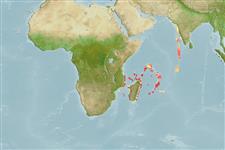Classification / Names
ຊື່ສາມັນ | ຄຳສັບຄ້າຍຄືກັນ | Catalog of Fishes(ຕະກຸນ, ຊະນິດ) | ITIS | CoL | WoRMS | Cloffa
>
Eupercaria/misc (Various families in series Eupercaria) >
Labridae (Wrasses) > Cheilininae
Etymology: Pteragogus: Greek, pteron = wing, fin + Greek, ago = to drive (Ref. 45335); variabilis: Named for the great variation in color, not only as shown in color photographs of different fish, but in the same individual..
Environment: milieu / climate zone / depth range / distribution range
ນິເວດວິທະຍາ
ສັດທະເລ ກ່ຽວກັນຫີນ; ລະດັບຄວາມເລິກ 0 - 71 m (Ref. 93522). Tropical
Indian Ocean: Mauritius, Seychelles (Aldabra Atoll), and Cargados Carajos (St. Brandon’s Shoals).
ຂະໜາດ / ນ້ຳໜັກ / Age
Maturity: Lm ? range ? - ? cm
Max length : 5.8 cm SL ຕົວຜູ້/ບໍ່ມີເພດ; (Ref. 93522)
Short description
ສະລີລະວິທະຍາ | ການວັດແທກຮູບຮ່າງລັກສະນະພາຍນອກຂອງດິນ,ສັດ,ປາ…
ຄີ (ໜາມ)ແຂງຢູ່ຫຼັງປາ (ທັງໝົດ): 11; ຄີຫຼັງຂອງປາ (ຄີອ່ອນ) (ທັງໝົດ): 9; ຄີ(ໜາມ) ແຂງຢູ່ຄີກົ້ນປາ
ກຸ່ມປາກະດູກແຂງ
ຄວາມຖີ່ຂອງກຸ່ມຖ່າຍທອດພັນ
ປາທີ່ມີການເຄື່ອນຍ້າຍຈາກທະເລໄປຫານ້ຳຈືດ ແລະນ້ຳຈືດຫາທະເລ
ປາທີ່ມີການເຄື່ອນຍ້າຍຈາກທະເລແລະໄປໄຂ່ຢູ່ນ້ຳຈືດ
ຄີກົ້ນຂອງປາ
ສັດທີ່ມີກະດູກສັນຫັຼງ
ການຖ່າຍທອດທາງກຳມະພັນຈາກພໍ່ແມ່ຫາລູກ 3-9; ຄີກົ້ນຂອງປາ: 9; ສັດທີ່ມີກະດູກສັນຫຼັງ: 24. This species is distinguished by the following characters: D XI,9; A III,9; pectoral rays 13-14 (usually 13), the rays flattened at tips but not branched; complete lateral line, angling sharply downward below soft portion of anal fin to straight peduncular part; pored scales 24 (plus 2 on base of caudal fin, the last greatly enlarged); body moderately deep, 2.7-3.05 depth in SL; head length 2.55-2.6 in SL; dorsal profile of head straight; straight part of posterior margin of preopercle serrate, serrae varying from 13 on 3.4-cm paratype to 25 on 5.8-cm paratype; absence of long filaments extending from tips of dorsal spines; rounded caudal fin and moderately long 3.1-3.15 in SL; first soft ray of pelvic fins moderately long, reaching between origin of anal fin and origin of soft portion of anal fin, 3.2-4.1 in SL. Colour in life very variable, with the ground color being brown, sometimes suffused with orange, red, or yellow; or greenish gray, orange-yellow, or red; all sharing the following features: opercle of darker color, often more red, orange, or yellow than rest of head, and containing an oblique elliptical ocellus; four white spots along anterior lateral line, the fourth anteriorly on caudal peduncle, with irregular white spots and flecks extending dorsally from first three spots into dorsal fin, and ventrally from all four spots; a broad white posterior border on preopercle, with an adjacent white triangular band on opercle; white dots extending ventrally and posteroventrally from orbit; median and pelvic fins colored much like adjacent body, but with more small white blotches and dots; dorsal fin with a blackish spot on first membrane and usually a smaller spot on second membrane; about posterior three-fourths of soft portion of fin transparent, except basally (the transparent zone may be crossed by brown lines); caudal fin with a series of white or transparent spots along dorsal margin and smaller spots along ventral margin; color in alcohol pale brownish yellow, an oblique elliptical ocellus about twice pupil diameter in length on opercle (often damaged, sometimes effaced), a short dark brown dash on side of snout before middle of eye, dark dots sometimes faintly visible on nape, fins translucent pale yellowish with the dorsal having a blackish spot on first membrane and usually a second smaller spot on second membrane, a small dark brown spot at rear base of dorsal fin; some specimens, including holotype, may be entirely pale yellowish with no dark markings (Ref. 93522).
Life cycle and mating behavior
ການຈະເລີນເຕັມໄວ | ການສືບພັນ | ການວາງໄຂ່ | ໄຂ່ | ຄວາມດົກຂອງໄຂ່ປາ | ຕົວອ່ອນ
Oviparous, distinct pairing during breeding (Ref. 205).
Randall, J.E., 2013. Seven new species of labrid fishes (Coris, Iniistius, Macropharyngodon, Novaculops, and Pteragogus) from the Western Indian Ocean. J. Ocean Sci. Found. 7:1-43. (Ref. 93522)
IUCN Red List Status (Ref. 130435)
Threat to humans
Harmless
Human uses
ການປະມົງ:
ຂໍ້ມູນຕື່ມອີກ
ຊື່ສາມັນຄຳສັບຄ້າຍຄືກັນການເຜົາໃໝ້ພະລັງງານໂດຍປ່ຽນທາດອາຫານໃນຮ່າງກາຍໃຫ້ກາຍເປັນຊີ້ນແລະໜັງຜູ້ລ້າການສຶກສາຜົນກະທົບຂອງສານຜິດທີ່ມີຜົນກະທົບຕໍ່ລະບົບນິເວດການສືບພັນການຈະເລີນເຕັມໄວການວາງໄຂ່ການສັງລວມການວາງໄຂ່ຄວາມດົກຂອງໄຂ່ປາໄຂ່Egg development
Age/Sizeການເຕີບໃຫຍ່Length-weightLength-lengthLength-frequenciesການວັດແທກຮູບຮ່າງລັກສະນະພາຍນອກຂອງດິນ,ສັດ,ປາ…ສະລີລະວິທະຍາຕົວອ່ອນການປ່ຽນແປງຂອງຕົວອ່ອນການທົດແທນທີ່ຄວາມອຸດົມສົມບູນBRUVS
ເອກະສານອ້າງອີງການລ້ຽງສັດນ້ຳຂໍ້ມູນການລ້ຽງສັດນ້ຳສາຍພັນກຳມະພັນElectrophoresesການຖ່າຍທອດທາງກຳມະພັນຈາກພໍ່ແມ່ຫາລູກພະຍາດການປຸງແຕ່ງNutrientsMass conversion
ຜູ້ຮ່ວມມືຮູບStamps, Coins Misc.ສຽງຫອຍມີພິດຊະນິດນຶ່ງທີ່ອາໄສໃນທະເລຄວາມໄວປະເພດການລອຍເນື້ອທີ່ເຫືອກOtolithsສະໝອງວິໄສທັດ
ເຄື່ອງມື
Special reports
Download XML
ແຫຼ່ງອີນເຕີເນັດ
Estimates based on models
Preferred temperature (Ref.
123201): 26.3 - 27.3, mean 26.5 °C (based on 10 cells).
Phylogenetic diversity index (Ref.
82804): PD
50 = 0.5010 [Uniqueness, from 0.5 = low to 2.0 = high].
Bayesian length-weight: a=0.02188 (0.00887 - 0.05395), b=2.97 (2.76 - 3.18), in cm total length, based on LWR estimates for this (Sub)family-body shape (Ref.
93245).
ຊັ້ນເຂດຮ້ອນ (Ref.
69278): 3.3 ±0.4 se; based on size and trophs of closest relatives
ຄວາມຢືດຢຸ່ນ (Ref.
120179): ສູງ, ປະຊາກອນຕຳ່ສຸດທີ່ໃຊ້ເວລາສອງໜ້ອຍກວ່າ 15 ເດືອນ (Preliminary K or Fecundity.).
Fishing Vulnerability (Ref.
59153): Low vulnerability (10 of 100).
